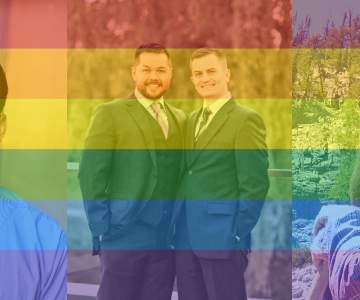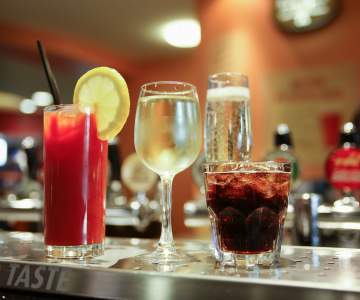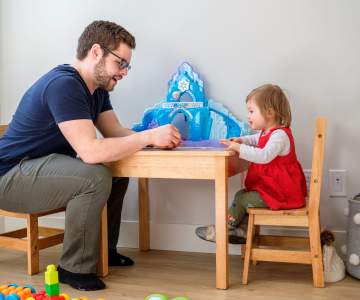Breadcrumb
Explore Stories
2 Minute Read
Community & Culture
Fifty-year-old Shane is an active volunteer, a former hockey player and a trivia buff.
Like many couples, he and his wife Joanne often tease each other.
“She doesn’t have a volume switch. I’ve been trying to find it for years,” he says of Joanne, who is so soft-spoken you need to lean in close to hear her.
“I didn’t come with a volume switch. Or a return policy,” Joanne quietly quips back.
Joanne and Shane moved to the Okanagan a few years ago, but it wasn’t easy. They spent time living outdoors when they were unable to find housing. Money ran out quickly.
Having experienced both substance use issues and homelessness, they know about shame and blame firsthand.
“Every homeless or drug addicted person I know has been impacted by stigma. If you carry a back-pack, you’re not allowed to use a washroom, even in a business where you eat every day,” Shane says.
”Stigma is everywhere. We need to get rid of it, for everyone. Not just for the homeless or addicted but as a race.” He pauses. “Whoa I’m getting deep now, holy cow.” He laughs to lighten the mood, but his words are true.
It was the impact of stigma that spurred Shane to begin advocating for marginalized people in their community. He is a co-founder of VEPAD – Vernon Entrenched People Against Discrimination – a support group of sorts, that is active in harm reduction efforts, community clean-ups, and education.
“Don’t paint everybody with the same brush and don’t be so quick to judge. It can happen to anyone. I’m proof of that,” Shane says. “I come from an upper middle class family. I was always a confident person until 10 years ago.”
“I’d never used drugs in my life. I didn’t drink much. All of a sudden one night I had a line of cocaine put in front of me, and I fell in love with it right then and there. I couldn’t get enough of it. I lost everything to it.”
The stigma surrounding homelessness and substance use weighs on you, Shane says, until you are looking down all the time and it feels like nobody cares about you.
When they were invited to share their lived experience at a business event, Shane realized how many people and agencies there are in town that do care.
“And now I guess we’re one of them,” he says, referring to VEPAD. “And I like that.”
Watch the video and learn about Shane's story. Check out more resources about stigma and substance use. Help #EndStigma.
Shane’s story is part two in a four part series of stories and videos about the stigma faced by those impacted by substance use.
3 Minute Read
Community & Culture
On June 28, 1969, police raided Manhattan’s Stonewall Inn, a meeting place for LGBTQ2+ people. When they demanded to conduct sex verification checks on trans women, a spontaneous protest broke out.
This protest started the conversation about LGBTQ2+ issues and the battle for acceptance and inclusion. It was also the start of what today we celebrate as Pride.
Fifty years later, Pride celebrations happen throughout the world and here in Canada during the summer. They include parades, picnics, parties, workshops, symposia and concerts. Memorials are also held for those members of the community who have been lost to hate crimes or HIV/AIDS.
Pride is an opportunity to recognize the impact of lesbian, gay, bisexual, transgender, queer and two spirit people in our communities.
. . .
As a community of more than 21,000 employees throughout B.C.’s interior, Interior Health’s people hold stories of both the painful past and the hopeful future of Pride.
….. Renee’s story:
“This month is a sombre time for me to remember some of the more painful experiences in my life. I think back on when my cousin’s teenage child committed suicide after coming out gay to an unaccepting family and was unable to get supportive health services. I remember when my friend’s child descended into depression, poverty and addiction after being fired from their job after coming out as trans. I also think of my friend who has been left permanently disabled after being stalked and savagely attacked while walking home from work, for no other reason than being visibly trans,” says environmental health officer, Renee Ansel.
“It’s important for organizations like IH to acknowledge Pride. We need to stand up – and not be complacent about cruel cultural values that ruin lives and tears families apart.”
… Allen’s story:
“I’m the ‘minority of the minority’ because I’m not white and not straight – a double whammy you might say. To take this even further, I’m a gay man working in a women-dominated workplace in health care – so perhaps that constitutes a triple whammy,” says medical laboratory technologist, Allen Lee.
“For a person of colour, and a person of the LGBTQ2+ community; diversity and inclusion is paramount to my career growth. It gives me a great pleasure and power to be myself in showing my creativity and passion in my work, which is an extension of my personal life. It’s important that minority voices like my own, are heard despite our skin colour, gender, culture differences, and abilities.”
… Lannon’s story:
“I’ve identified with the LGTBQ2+ community since my late teenage years. I have been blessed throughout my life to be supported by family and friends and to have very rarely experienced discrimination,” says Lannon De Best, clinical operations director for the North Okanagan.
“Differences are important in our communities and in our workplaces. Difference is what creates space for us to find the best solutions.”
“In my life, I’ve learned a small degree of change can take you down a new path, to a new place and that’s what I hope for.”
. . .
For support and information, explore local resources in your community or visit these links:
What Does Two-Spirit Mean? (video)Trans Care BCPFLAG CanadaEgale CanadaWhat's ON Queer BCAMSSA: Resources to Support LGBTQ2 Newcomers
3 Minute Read
Health & Wellness
We live in a society that not only normalizes alcohol use, but seems to endorse it. “It’s 5 o’clock somewhere,” after all.
Alcohol consumption has been steadily increasing over the years, and according to the University of Victoria alcohol monitoring project, people living in the Interior Health region have the highest rate of alcohol consumption in the province.
The risks of alcohol consumption
“Alcohol is such a common substance in our culture that the harms are often overlooked,” says Substance Use Practice Lead Amanda Lavigne.
According to the BC Centre for Substance Use, high risk drinking can lead to disease, social problems, and economic costs.
Each day 10 Canadians die in hospital from harm caused by substance use, and three in four of these deaths are due to alcohol.
These harms have been magnified during the COVID-19 pandemic as many people turn to alcohol as a coping tool, and this behaviour is being normalized on social media. Although humour itself is often used to help cope with stress, this can have the unintended effect of making uncommon consumption behaviours seem more socially acceptable.
Humour such as memes on social media can normalize high-risk drinking.
According to the Canadian Centre on Substance Use and Addiction, 25 per cent of Canadians aged 35-54 and 21 per cent aged 18-34, reported an increase in their alcohol consumption while spending more time at home due to physical distancing and self-isolation protocols. Some of the reasons for increased alcohol use include a change of schedule, boredom, and stress during the COVID-19 pandemic. A May 15 article from The Capital states that in just two months, B.C. has sold four Olympic swimming pools of “extra booze”, saying it is likely “the sharpest spike in collective drinking since the end of prohibition.”
Alcohol negatively impacts the immune system, putting those who consume it at higher risk from the potentially dangerous COVID-19 virus.
How COVID-19 can add to the risk of withdrawal
People with alcohol use disorder may have their supply interrupted due to self-isolation, or financial hardship. Marginalized people, such as those without homes or jobs, may rely on pan-handling and collecting cans and bottles in order to buy alcohol, however during COVID-19 they are being significantly impacted due to recycling depot closures and limited public interaction.
This can increase the likelihood of withdrawal, which can be deadly in the case of some high-risk drinkers.
In response to this, Interior Health has implemented managed alcohol programs in Kelowna, Kamloops and Vernon with ongoing planning to expand to other communities.
Kelowna Mental Health and Substance Use Manager Nadine Rigby recalls one client’s reaction: “The client was almost in tears when he received his first dose. He was extremely grateful and stated that he couldn’t believe that we cared enough to provide this service for him.”
“Without this program, he would have gone into withdrawal and ended up in hospital.” Nadine Rigby, MHSU Manager
While the managed alcohol programs focus on the most vulnerable population in this pandemic, safer drinking guidelines should be followed by everyone who uses alcohol. Low-risk drinking guidelines recommend less than 10 drinks a week for women, with no more than two drinks a day most days, and 15 drinks a week for men, with no more than three drinks a day most days.
“Taking a harm reduction approach can help everyone who consumes alcohol. Harm reduction could look like diluting your wine with soda water and ice or having a non-alcohol beverage in between drinks to slow down consumption,” says Amanda.
Want to learn more?
If you are concerned about your alcohol consumption, talk to your primary care provider about creating shared goals and improving your health.
Check out these helpful resources and sources of information:
Canadian Center on Substance Use and Addiction: Alcohol
Canadian Institute for Health Information
COVID-19 Alcohol and Cannabis Use
Canada’s low-risk guidelines (also see video)
COVID-19- Safer drinking tips
BC Alcohol consumption (statistics)
Interior Health Substance Use Services
Alcohol: Drinking and Your Health (HealthLinkBC)
Alcohol and Immune System
1 Minute Read
Community & Culture
A white heart is a symbol commonly used to convey hope, pure thought and steadfast intention.
The White Heart Project was created by the Kelowna General Hospital Foundation and inspired by a deep appreciation for health-care staff and the tremendous sacrifice they are making.
In recent weeks, white hearts have sprung up across hospitals and communities throughout B.C.'s interior.
Other hospital foundations have joined the movement, including: Kamloops, Vernon, Shuswap, Salmon Arm, Guelph, Medicine Hat, and Whistler.
Want to join in?
Check out the White Heart Project online
Download and display the signature White Heart on your door
Join the #whiteheartproject on social media
The walkway at Kelowna General Hospital
Harmony Honda in Kelowna displays their white hearts.
A construction site displays a white heart.
Centennial hall at Kelowna General Hospital.
Kelowna grocery store displays their white heart.
5 Minute Read
Health & Wellness
When Harm Reduction Coordinator Lesley Coates received the latest quarterly report on provincial overdose statistics, it confirmed what she and colleagues had been hearing anecdotally from the community for weeks. They had seen a steady, yet slow decline in overdose deaths over the last two years (139 in 2019, compared to 233 in 2018). The first three months of 2020 were painting a different picture.
Between January and March 2020, 46 people in the IH region lost their lives because of an overdose.
B.C. has two public health emergencies intersecting: The ongoing public health emergency declared in April 2016 due to increasing opioid overdoses and deaths, and the COVID-19 public health emergency declared on March 17, 2020.
Harm Reduction Coordinators, Medical Health Officers and Mental Health & Substance Use (MHSU) staff across Interior Health have the unique challenge of responding to these concurrent health crises.
“Our team has been fielding calls from a number of harm reduction agencies and community partners in several communities over the last few weeks. Many regions are reporting an increase in overdose activity."
“We have an increasingly unpredictable drug supply right now, so taking steps to prevent overdose is very important.” Harm Reduction Coordinator Lesley CoatesThe Mental Health and Substance Use Network has been working with program directors across the region to assess the impact the COVID-19 response has had on overdose response and make adjustments where necessary.
“We want to make sure that the improvements we've made through targeted interventions are not lost. For example, we need to ensure Take Home Naloxone kits and other harm reduction supplies continue to be available, and that there are no new barriers to accessing Opioid Agonist Treatments as a result of COVID-19,” says Substance Use Director Corinne Dolman. “There is no doubt that it has been a particularly difficult period of time for many people, including people who use drugs, and some have been significantly impacted by this pandemic.”
“Are the important measures we are taking to flatten the curve impacting overdose risk? Certainly components of the COVID-19 response may change how and where illicit drugs are made; physical distancing may separate us from important supports and services; and people may become apprehensive to seek or offer care due to fear of COVID-19 infection. At the same time, people are more stressed and many have lost jobs. There is a real risk for mental health issues to be exacerbated, and for alcohol and drug consumption to increase,” says Medical Health Officer Dr. Karin Goodison.
According to the B.C. Centre for Substance Use, COVID-19 is a virus that can cause a respiratory infection and other health problems, and Fentanyl and other opioids can slow a person's breathing rate, so COVID-19 may increase the risk of overdose death from opioids.
In these complex times, Dr. Goodison says social connections can and should continue. Essential services, such as drug checking, overdose prevention sites and supervised consumption services, Naloxone distribution and access to treatment and support continue to be available, but in some cases these services may look slightly different.
“We can, and we will, continue to move forward to address both of these public health emergencies."Dr. Karin Goodison
"We will continue to support people to stay safe whether they are keeping their distance when exercising, or using drugs with a buddy or at an overdose prevention site. In fact, we just opened our new overdose prevention service in Vernon with appropriate COVID-19 prevention measures in place.”
Interior Health urges anyone who uses drugs to take steps to prevent overdose.
How to prevent overdose and use drugs safer during COVID-19:
Buddy up when you are using. COVID-19 is passed by droplets. Stay two metres (6.5 ft.) from your buddy to avoid passing the virus. Using with a buddy is safer than using alone.If self-isolating, find your buddies who can bring you food, harm reduction supplies, medicine, and substances so that you can stay well. You can also be a buddy to those who may need extra support. Check in on your buddies regularly.Continue to use overdose prevention services, supervised consumption sites and supportive housing overdose prevention sites. Thorough cleaning that takes place at these sites will help reduce the spread of infection.Continue to use drug checking services. For locations visit: www.drugchecking.ca. Call ahead as hours may have changed.Don’t mix different drugs (including pharmaceutical medications, street drugs, and alcohol).Use less and pace yourself. Do testers to check strength – take a small sample of a drug before taking your usual dosage.Carry a Naloxone kit and know how to use it. A list of locations to get a kit can be found on the Toward the Heart.Recognize the signs of an overdose: slow or no breathing, gurgling or gasping, lips/fingertips turning blue, difficult to awaken, or non-responsive.If someone is experiencing an overdose or is witnessing an overdose, follow overdose response steps outlined by the BC Centre for Disease Control, and call 9-1-1 immediately.Consider treatment options – talk with your health-care provider or contact one of our Mental Health and Substance Use offices, which offer a full range of services to improve the health and well-being of people with substance use problems.Want to learn more? Check out these resources:
Overdose prevention and COVID-19 Supervised Consumption Services in Kelowna and Kamloops Overdose Prevention Site at the Vernon Downtown Primary Care CentreOverdose Prevention Site in NelsonInterior Health overdose emergency web pageInterior Health's Mental Health and Substance Use Centres
3 Minute Read
Community & Culture
Two registered nurses from Royal Inland Hospital (RIH) proved Saturday that love will prevail even in the time of COVID-19.
When Amanda McKay and James Futerko couldn’t have the wedding of their dreams, they chose a different option that honoured their colleagues and the workplace where they met.
On Saturday, standing before a marriage commissioner in the roundabout traffic circle at RIH, the couple exchanged vows in front of family and friends, all positioned strategically apart from each other.
As a slight wind blew and vehicles came to a standstill, guests watched from around the sidewalk and the second, third and fourth levels of the parkade. When the ceremony ended, a loud cheer went up and applause broke out – the cloud of the pandemic momentarily forgotten.
It was a fitting start for the marriage of Amanda, an Emergency and Intensive Care Unit (ICU) registered nurse, and James, an registered nurse on the High Acuity Response Team, who met on the job at RIH in 2017 when Amanda was filling a temporary position in the ICU.
“We were going to get married in Chilliwack on James’ family farm. When the pandemic started, we realized we had to do something different, but also something special,” said Amanda.
Someone joked they should get married at the hospital and the idea, amusing at first, took on the grains of a possibility that became a reality with the support of Interior Health and RIH leadership.
L-R: Matt Stubbings, Richard Jewitt, bride and groom and Shanta Rishy-Maharaj. Photo courtesy of Captured by Nicole Photography.
“We were happy to support Amanda and James in holding their wedding on site,” said Richard Jewitt, RIH clinical director who oversees the Emergency Department. “It is important to recognize that positive events can take place at this time, even as we adhere to public health standards such as physical distancing.”
For Amanda and James, the unusual wedding location meant they were getting married at a place close to their hearts.
“I really love working here,” said Amanda. And despite COVID-19, the timing was perfect.
Two nurses getting married during National Nurses Week, in the Year of the Nurse, and in the midst of the biggest health emergency since 1918.
How they got engaged
James and Amanda are avid mountain bikers and they prefer that special events reflect what they value in their lives. So, last September James made a plan.
He got a ring and arranged a bike ride up Vedder Mountain in Chilliwack on a date he hoped would be a perfect fall day. They woke up to pouring rain and cold wind. Fortunately, Amanda is a hearty type – as nurses tend to be. With no hint of what was ahead, she agreed to put on her rain gear, climb on her bike and away they went, the weather getting worse all the time. Splashing uphill through mud puddles, they arrived at the location James had in his mind for his proposal.
He turned on the music in preparation to pop the question, but other cyclists at the same spot delayed him. So he asked her to dance – which they also both love to do – in the mud instead. They danced through his proposal song, “Georgia,” and then the coast was clear. He acted quickly, getting down on one knee and while a song played that neither can even remember now, he asked her the question.
The shocked and muddy bride-to-be asked, “What? This is happening now?” And then she said yes.
2 Minute Read
Health & Wellness
Cancer treatment can be one of the most exhausting emotional and physical experiences, both for the person living with it, and for their family.
Now imagine the added anxiety and complexity of needing care during the COVID-19 pandemic, and that exhausting experience has just become even more challenging.
While cancer care teams across Interior Health have worked tirelessly to protect these vulnerable patients, Dr. Phillip Malpass, a community oncologist from Nelson, realized he could take additional steps to support his patients while being mindful of COVID-19 precautions. He quickly pivoted his care model to incorporate virtual care for some of his patients.
“As physicians, we always strive to bring care closer to home. Virtual technology allows us to bring that care right to patients – in the comfort of their community, and in the comfort of their home,” says Dr. Malpass.
Dr. Phillip Malpass
Although exploring and expanding options for virtual care is not a new concept in Interior Health, the challenges brought on by the COVID-19 pandemic has quickly moved the concept to the forefront for care providers across the region.
The option of virtual appointments allows Dr. Malpass’ patients the option of having additional family members or caregivers also participate in appointments – increasing their comfort and allowing them the support they need, when they need it.
It’s all about removing obstacles to care, he says. Because of technology, his patients (especially those in rural areas) are able to reduce travel, save time, and spend less effort and money getting to appointments. These things can make a significant impact on people who may be feeling unwell, and impacts families already struggling to provide care and emotional support.
Beyond patient visits, Dr. Malpass also uses virtual technology to connect with the multidisciplinary team with whom he meets regularly. This allows the team to collaborate and provide a cohesive circle of care for people living with cancer, all while observing social and physical distancing and keeping safe themselves.
Dr. Malpass’ commitment to the virtual approach is more comfortable for patients and for staff – and it’s resulting in safe, quality oncology care in the Nelson area.
4 Minute Read
Community & Culture
When Williams Lake physician Dr. Ivan Scrooby and infection prevention lead Kelly Dillon were walking through a partially-remediated area of Cariboo Memorial Hospital (CMH) in Williams Lake earlier this year, inspiration struck.
The two were inspecting an area of the hospital that was already under construction and included ambulatory care, part of patient registration and the cardiology department. The area had been damaged by floods in January, the result of a series of burst pipes due to severe cold temperatures, and a negative pressure system was in place to remove construction dust from the area.
Due to the construction, the area was already cordoned off and completely separate from the rest of the hospital; the area was fully enclosed and fans were moving air outside as part of the remediation work.
At that time, the COVID-19 crisis was just beginning and hospitals had been asked to postpone surgeries and prepare for what could be an increase in patients who were ill due to COVID-19. Dr. Scrooby and Kelly immediately saw an opportunity to create a protected patient care area that would help limit the virus from spreading throughout the rest of the hospital.
“We went down together to have a look at the repairs and, when we walked through the space, we realized it had the potential to become a negative pressure space without having to do too much work,” says Dr. Scrooby, who inquired of the contractors if the negative pressure system could remain in place.
Cariboo Memorial Hospital in Williams Lake created a negative pressure area to allow staff to treat patients with COVID-19.
“From there the idea grew and we worked with our team at CMH and the contractor to make a few more improvements so we would be ready for potential COVID-19 patients.”
“Our departments had already been juggled around because of the flood repairs,” says Thalia Vesterback, CMH Director of Clinical Operations. “The silver lining was we had already looked at space utilization and that space that was under construction in our pandemic planning. It was a perfect solution to use the space that was being remediated due to the floods.”
* * *
During a particularly frigid cold snap in January, CMH was hit by a series of burst pipes and the hospital was thrown for a loop with its main, emergency and temporary public entrance all having to close down during the same week.
Temperatures had plunged below minus-30 C. Pipes were failing and water leaked throughout the hospital. The main water system to CMH had to be shut down. A few services became unavailable but, through it all, patient care wasn’t impacted.
“We had five separate pipes burst over a week and it kind of became like Groundhog Day, with staff responding all over again every day, in all of the different units,” says Thalia. “It really did bring everyone in the building together and there was just exceptional teamwork from all of our staff and physicians.”
Once the temperatures rose above normal, it was time for remediation work to begin. A large area was hoarded off as a restoration company worked to repair areas that were damaged. As repairs were nearing completion, hoarding remained up and a negative pressure system was in place to protect staff and patients from any construction dust. It was then that the province was hit with the COVID-19 crisis.
Enter Dr. Scrooby and Kelly Dillon's light-bulb moment. When the contractor returned to CMH to complete the restoration work, a few tweaks were made to the area. Two separate staff entrances were established where physicians and nursing staff could enter and don Personal Protective Equipment (PPE), and then exit when treatment was complete. Patients would also have a separate entrance, maintaining isolation protocols during the COVID-19 crisis.
“We are eternally grateful for all of the team players that made this happen,” says Dr. Scrooby. “It’s very comforting to treat patients that are very sick in the unit because we know we are limiting the exposure risk. With the staff and physicians wearing the proper PPE, we are protected, and so are the staff and the patients that are admitted into the regular hospital. I want to extend my gratitude to everyone for all of their hard work. We are serving a large rural community so it’s a bit challenging at times, but this has gone a long way in helping us if we have an outbreak to deal with.”
“This is just one more example of how amazing our health-care team is at Cariboo Memorial,” adds Kelly. “We work hard every day and it shows.”
Thalia echoed both of those comments, heartened by the way everyone pulled together, not only at the start of the COVID-19 response, but to the flooding earlier in the year as well.
“I think everybody has been fabulous, they have been amazing,” she says. “Everyone just pulled together. It started with the flooding and people chipping in and asking ‘how do we do this?’ Everyone was willing to come together and discuss solutions to the problem. It was a lot of effort from so many people and it really ended up being a great thing.”
2 Minute Read
Community & Culture
Medical students based at the UBC Okanagan campus in Kelowna are helping front-line physicians in the battle against COVID-19 in the B.C. Interior.
With the temporary suspension of clinical training in hospitals and clinics across the province, many medical students began looking for other ways to support physicians and patients during the pandemic.
Over 80 students joined the B.C. COVID-19 medical student response team, a UBC student-led initiative supporting physicians and volunteer projects in all regions of the province.
“Volunteering is a tangible and effective way to make a difference,” says Alex Monaghan, medical student and volunteer organizer. “We wanted to get involved out of appreciation and gratitude for those working to keep us protected and safe.”
From providing childcare and personal assistance to physicians, to supporting patients remotely, students have rallied together to offer their support across the Interior Health region.
Students have helped configure tablets with video messaging applications to help patients at Kelowna General Hospital (KGH) stay connected with their families. They also recently launched a meal preparation and delivery service to support physicians and their families.
“As we adjust, both personally and professionally to the new realities of life with COVID-19, I’m deeply encouraged by the generosity and solidarity of this newest generation of future physicians,” says Dr. Sarah Brears, Interim Regional Associate Dean for the Southern Medical Program and family physician. “The extra support they’re offering to the community is helping many physicians stay focused on their work and their patients.”
Medical student Brian Hayes is one of the volunteers helping out by entertaining the busy 18-month old of a local physician working at KGH.
For Hayes, volunteering is a small way to give back during an unprecedented time.
"As individuals committed to providing care to the public, we have a strong desire to assist those on the front lines,” says Hayes. “Volunteering our time to support physicians with an inflated workload or help with projects such as contact tracing allows us to be engaged in the COVID-19 response."
As the COVID-19 pandemic continues to evolve, students remain committed to volunteering with projects that can support physicians, patients, and the health-care system as a whole.
“We chose medicine because we have a deeply ingrained desire to make a difference in the lives of those around us,” says Monaghan. “Those values don’t disappear just because there’s a pause in our clinical training. We’re here to help in whatever form that takes.”
Reprinted with permission from The University of British Columbia, Okanagan Campus
-
Load More
Showing 648 of 679
STAY CONNECTED
Receive news and alert posts, and Stories@IH blog posts, right to your inbox!









